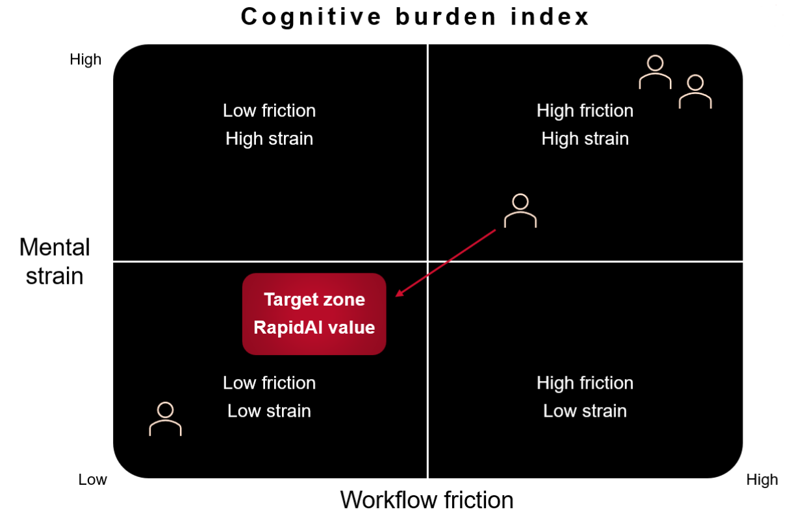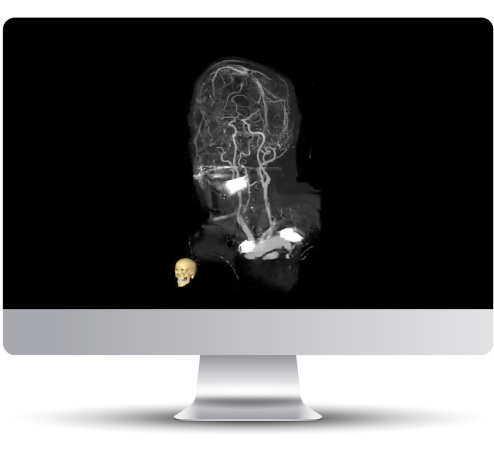The reality of cognitive burden, in radiologists’ own words
Radiologists often describe cognitive burden not as the difficulty of interpretation itself, but as the accumulation of mental strain throughout the day. One radiologist captured it simply:
“It’s not the reading, it’s everything around the reading.”
The constant app switching, the pressure of accuracy under time constraints, the fragmented systems, the alerts, the interruptions, the manual steps that pull attention away from the diagnostic moment. This friction adds up.
Across conversations, surveys, and workflow analyses, one equation consistently emerges:
Mental strain + workflow friction = cognitive burden.
And the effects reach far beyond the workstation. Cognitive burden contributes to:
- Fatigue that sets in earlier and hits harder
- Moments of uncertainty or second-guessing
- Variability in diagnostic performance
- Slower workflows and decreased precision
- Erosion of well-being and quality of life
More than a third of radiologists say this strain is pushing them toward wanting to leave their role. Cognitive burden has become the hidden cost of radiology. It deserves to be acknowledged with honesty, empathy, and practical solutions.
The growing cognitive burden in radiology
Radiologists today face unprecedented pressure as imaging volumes rise and case complexity expands. Each case carries more images, more reconstructed views, and more clinical inputs to reconcile. What was once a focused, methodical discipline has become a constant balancing act across multiple systems, modalities, and interruptions.
Cognitive burden is not merely an issue of productivity. It is a performance limiter. When mental strain and workflow friction intensify, vigilance declines and error risk rises. Studies show rising rates of burnout in radiology, with nearly forty percent of radiologists expressing a desire to leave the profession due to sustained cognitive overload¹.
This challenge is amplified by fragmented workflows. Radiologists may toggle between PACS, reporting tools, communication platforms, EHR data, and third-party visualization tools during a single read. Every interruption pulls focus from the clinical moment and adds invisible load.
AI can help address these pressures. RapidAI’s radiology solutions provide explainable insights, automation, and workflow unification. By reducing cognitive burden at each step of the reading process, these tools support radiologists in delivering faster, more consistent decisions with greater clarity and confidence.
What radiologists told us matters most
To better understand where cognitive burden peaks, RapidAI surveyed forty radiologists across eight institutions, representing a range of subspecialties and experience levels. Their answers reflected what many radiologists know intuitively: it is the cumulative weight, not the individual tasks, that wears on them most.
The top pressure points identified included:
- Manually generating perfusion maps
- Communicating findings with ordering physicians
- Jumping between PACS, EHR, communication, and reporting systems
- Reconstructing vessels and performing manual measurements
-
Tracking priors and comparing studies across time
Many of these tasks aren’t “hard” in isolation. It is the combination of mental switching, manual steps, and cognitive effort that drains energy over time.
When respondents used RapidAI, they reported something meaningful:
A sixty percent reduction in cognitive burden across both diagnostic and administrative tasks.
More experienced radiologists described it as “getting back mental bandwidth” or “feeling less drained at the end of the day.” For them, this was more than efficiency. It was relief.


Understanding cognitive burden in clinical imaging
Cognitive burden includes both the mental effort required to interpret images and the friction that comes from managing fragmented workflows. Radiologists spend significant time preparing studies before interpretation even begins. This includes retrieving priors, generating 3D reconstructions, aligning images, and navigating between multiple systems.
RapidAI defines cognitive burden as the mental effort required to process complex information under time pressure, multiplied by the friction introduced by interruptions, context switching, and system fragmentation. When these two forces converge, focus and precision decline.
Repeated administrative tasks and manual data preparation consume time that radiologists would prefer to spend interpreting images and correlating clinical findings. Each click, switch, and interruption adds incremental load that contributes to burnout.
Tools like RapidAI’s Lumina 3D help streamline this preparation process by automating reconstruction. By eliminating a manual process, whether reconstructed in-house or via an external third party, Lumina3D increases clarity at the start of each case and frees radiologists to focus on interpretation. For a deeper look at how integrated AI helps solve workflow fragmentation, explore the blog on scaling AI from siloed tools to an enterprise platform.
The impact of diagnostic fatigue and bias
Long reading shifts, high case volumes, and complex imaging demands take a measurable toll on attention. Radiologists must maintain concentration during repetitive tasks, deep reviews, and high-stakes decision-making. Over time, cognitive endurance declines.
Diagnostic fatigue is not just physical. It is deeply cognitive. Radiologists expend mental energy scanning for abnormalities, confirming findings, and performing manual calculations. The more frequently these tasks are repeated, the more quickly fatigue sets in.
This fatigue contributes to¹²³:
- Increased risk of perceptual misses
- Narrowed attention and reduced global awareness
- Slower decision making late in shifts
- Greater variability in diagnostic performance
AI overlays, automated measurements, and advanced visualization provide support by reducing the mental energy required to maintain constant vigilance. Instead of scanning for every potential signal, radiologists can validate and contextualize AI-generated insights while preserving cognitive resources for more complex tasks.
How RapidAI reduces cognitive burden by design
Deep clinical AI: easing the mental load
Radiologists often say that the challenging part is not identifying the obvious, but staying mentally sharp during the dozens of small, repetitive steps required for each case. Deep clinical AI helps by:
- Highlighting what deserves attention first
- Automating quantification and contextualization
- Reducing manual measurements and setup
- Clarifying areas of concern with explainable overlays
This does not replace radiologists. It supports them by absorbing the cognitive weight of repetitive microtasks.

Workflow integration: reducing the friction that breaks focus
Radiologists consistently describe workflow fragmentation as a major source of cognitive strain. Their minds are constantly pulled between systems, alerts, and communication channels.
Navigator Pro was built around this reality. It unifies:
- Worklist prioritization
- Deep clinical AI findings directly in the workspace (Rad Assistant)
- Team communication and consults
- Automated reporting
With everything needed in one workspace, radiologists can stay centered and focused. This reduces interruptions and helps maintain diagnostic clarity throughout the day.
Human-centered design: supporting clarity, confidence, and well-being
Radiology is a profoundly cognitive profession. Radiologists make countless mental decisions throughout the day, and they need tools that respect how they think and work.
Human-centered design in RapidAI tools supports that goal by:
- Minimizing noise and distractions
- Reducing mental switching costs
- Presenting information visually and contextually
- Creating a calmer, more predictable reading environment
This is not technology for technology’s sake. It is technology that recognizes the human mind behind every scan.
A quiet backbone that matters
Radiologists shared that they do not want to think about infrastructure. They simply want it to work.
Rapid Edge Cloud exists to ensure that intelligence is available system-wide, reliably, and securely. It is the quiet backbone that enables the human-centered experience to shine. Fast. Consistent. Scalable. Effective without demanding attention.
Reclaiming focus and balance in radiology
When workflow friction and mental strain converge, radiologists face declining performance, increased variability, and higher burnout risk. Reducing this burden is not just an operational priority. It is a clinical imperative.
Navigator Pro helps radiologists bring their best to every read by lightening the mental load and creating a unified workspace that supports sharper focus and greater consistency. In the RapidAI survey, radiologists reported a sixty percent reduction in cognitive burden after implementing RapidAI tools. More experienced radiologists saw the greatest improvement, underscoring the importance of mental clarity in advanced interpretation.
This is not about redefining radiology. It’s about rewiring the cross between technology and human impact to create an environment that supports radiologists and lightens their cognitive burden.
To see how this transformation works in practice, explore the RapidAI content hub article on AI that aligns with healthcare leaders and the supporting blog on integrating AI into radiology workflows.
FAQs
What is cognitive burden in radiology?
Cognitive burden refers to the mental effort required to process complex imaging data, interpret findings, and manage multiple workflows. When workloads are high and systems are fragmented, cognitive burden increases, leading to fatigue and reduced accuracy.
How does deep clinical AI reduce cognitive burden for radiologists?
Deep clinical AI automates repetitive tasks such as image reconstruction, measurements, and case comparison. This allows radiologists to spend more time on interpretation and less on manual preparation, documentation, and communication.
Can automation improve diagnostic accuracy?
Yes. AI enhances consistency and can reduce human error by surfacing findings, standardizing views, and supporting actionable clinical context that reveals what the system detects and how confident it is.
Does reducing cognitive burden improve patient outcomes?
Absolutely. When radiologists are less fatigued and more focused, findings are reported faster and more accurately. This leads to quicker treatment decisions and better overall patient care.
How does RapidAI support radiologists across the enterprise?
RapidAI integrates deep clinical AI across modalities and systems, from triage and interpretation to communication and workflow management. The platform helps hospitals achieve faster, more consistent care coordination across service lines and radiology programs.
References
- European Journal of Radiology. “Mental workload and diagnostic performance in radiology.” EJR, 2023.
- RadioGraphics. “Cognitive load and its impact on radiology practice.” RadioGraphics, 2022.
- Academic Radiology. “Cognitive fatigue, diagnostic variability, and workflow factors in radiology.” Academic Radiology, 2023.
- American College of Radiology (ACR). “Radiologist burnout and workforce pressures.” ACR, 2023.
- Everlight Radiology. “Radiologist well-being and burnout trends.” Everlight Radiology Report, 2025.
- RapidAI Cognitive Burden Survey. Internal survey of 40 radiologists across 8 institutions, 2025.
- AHA/ASA Guidelines. “Guideline for the management of patients with spontaneous intracerebral hemorrhage.” Stroke, 2022 (used when referencing hemorrhage-related stats if included elsewhere in the blog).


